Related Research Articles

Okinawa Prefecture is a prefecture of Japan. Okinawa Prefecture is the southernmost and westernmost prefecture of Japan and has a population of 1,457,162 and a geographic area of 2,281 km2.

United States Forces Japan (USFJ) is a subordinate unified command of the United States Indo-Pacific Command. It was activated at Fuchū Air Station in Tokyo, Japan, on 1 July 1957 to replace the Far East Command. USFJ is headquartered at Yokota Air Base in Tokyo and is commanded by the Commander, US Forces Japan who is also commander of the Fifth Air Force.

Yomitan is a village located in Nakagami District, Okinawa Prefecture, Japan.
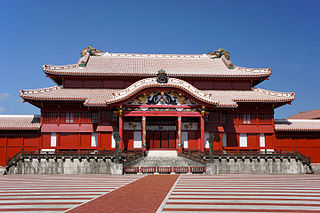
This article is about the history of the Ryukyu Islands southwest of the main islands of Japan.
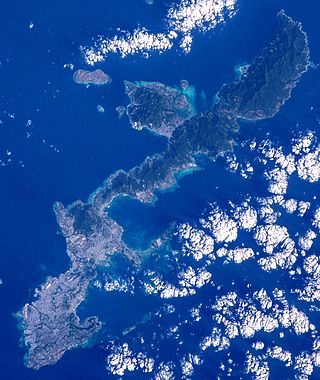
Okinawa Island, officially Okinawa Main Island, is the largest of the Okinawa Islands and the Ryukyu (Nansei) Islands of Japan in the Kyushu region. It is the smallest and least populated of the five main islands of Japan. The island is approximately 106 kilometres (66 mi) long, an average 11 kilometres (7 mi) wide, and has an area of 1,206.98 square kilometers (466.02 sq mi). It is roughly 640 kilometres south of the main island of Kyushu and the rest of Japan. It is 500 km northeast of Taiwan. The total population of Okinawa Island is 1,384,762. The Greater Naha area has roughly 800,000 residents, while the city itself has about 320,000 people. Naha is the seat of Okinawa Prefecture on the southwestern part of Okinawa Island. Okinawa has a humid subtropical climate.

Marine Corps Air Station Futenma or MCAS Futenma is a United States Marine Corps base located in Ginowan, Okinawa, Japan, 5 NM northeast of Naha, on the island of Okinawa. It is home to approximately 3,000 Marines of the 1st Marine Aircraft Wing and other units, and has been a U.S. military airbase since the defeat of the Japanese Imperial Army in the Battle of Okinawa in 1945. Marine Corps pilots and aircrew are assigned to the base for training and providing air support to other land and sea-based Marines in Okinawa and throughout the Asia-Pacific region. MCAS Futenma is part of the Marine Corps Installations Pacific command.

III Marine Expeditionary Force is a formation of the Marine Air-Ground Task Force of the United States Marine Corps. It is forward-deployed and able to rapidly conduct operations across the spectrum from humanitarian assistance and disaster relief (HA/DR) to amphibious assault and high-intensity combat.
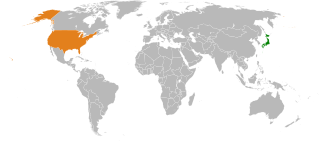
International relations between Japan and the United States began in the late 18th and early 19th century with the diplomatic but force-backed missions of U.S. ship captains James Glynn and Matthew C. Perry to the Tokugawa shogunate. Following the Meiji Restoration, the countries maintained relatively cordial relations. Potential disputes were resolved. Japan acknowledged American control of Hawaii and the Philippines, and the United States reciprocated regarding Korea. Disagreements about Japanese immigration to the U.S. were resolved in 1907. The two were allies against Germany in World War I.
The United States foreign policy toward the People's Republic of China originated during the Cold War. At that time, the U.S. had a containment policy against communist states. The leaked Pentagon Papers indicated the efforts by the U.S. to contain China through military actions undertaken in the Vietnam War. The containment policy centered around an island chain strategy. President Richard Nixon's China rapprochement signaled a shift in focus to gain leverage in containing the Soviet Union. Formal diplomatic ties between the U.S. and China were established in 1979, and with normalized trade relations since 2000, the U.S. and China have been linked by closer economic ties and more cordial relations.

The Ryukyu independence movement or the Republic of the Ryukyus is a political movement advocating for the independence of the Ryukyu Islands from Japan.
The String of Pearls is a geopolitical hypothesis proposed by United States political researchers in 2004. The term refers to the network of Chinese military and commercial facilities and relationships along its sea lines of communication, which extend from the Chinese mainland to Port Sudan in the Horn of Africa. The sea lines run through several major maritime choke points such as the Strait of Mandeb, the Strait of Malacca, the Strait of Hormuz, and the Lombok Strait as well as other strategic maritime centres in Pakistan, Sri Lanka, Bangladesh, the Maldives, and Somalia.
President Barack Obama's East Asia Strategy (2009–2017) represented a significant shift in the foreign policy of the United States. It shifted the country's focus away from the Middle Eastern/European sphere and allowed it to invest heavily in East Asian countries, some of which are in close proximity to the People's Republic of China.
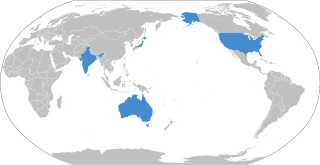
The Quadrilateral Security Dialogue (QSD), commonly known as the Quad, is a strategic security dialogue between Australia, India, Japan and the United States that is maintained by talks between member countries. The dialogue was initiated in 2007 by Japanese Prime Minister Shinzo Abe, with the support of Australian Prime Minister John Howard, Indian Prime Minister Manmohan Singh and U.S. Vice President Dick Cheney. The dialogue was paralleled by joint military exercises of an unprecedented scale, titled Exercise Malabar. The diplomatic and military arrangement was widely viewed as a response to increased Chinese economic and military power.
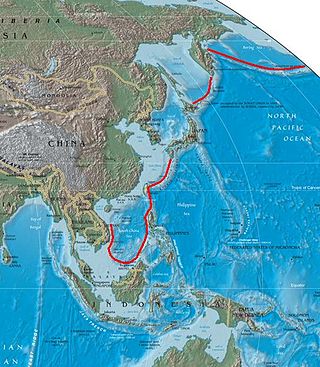
The first island chain refers to the first chain of major Pacific archipelagos out from the East Asian continental mainland coast. It is principally composed of the Kuril Islands, the Japanese archipelago, the Ryukyu Islands, Taiwan (Formosa), the northern Philippines, and Borneo, hence extending all the way from the Kamchatka Peninsula in the northeast to the Malay Peninsula in the southwest. The first island chain forms one of three island chain doctrines within the island chain strategy in the U.S. foreign policy.
The Okinawa Reversion Agreement was an agreement between the United States and Japan in which the United States agreed to relinquish in favor of Japan all rights and interests under Article III of the Treaty of San Francisco, which had been obtained as a result of the Pacific War, and thus return Okinawa Prefecture to Japanese sovereignty. The document was signed simultaneously in Washington, DC, and Tokyo on June 17, 1971, by William P. Rogers on behalf of United States President Richard Nixon and Kiichi Aichi on behalf of Japanese Prime Minister Eisaku Satō. The document was not ratified in Japan until November 24, 1971, by the National Diet.

Over the last five decades there have been various plans for the relocation of Marine Corps Air Station Futenma, a United States Marine Corps base located within the urban area of Ginowan City in Okinawa, Japan. The current proposal for a new site in Henoko Bay, Nago, has faced opposition from Okinawans and the local government who wish for the new base to be located off the island altogether.
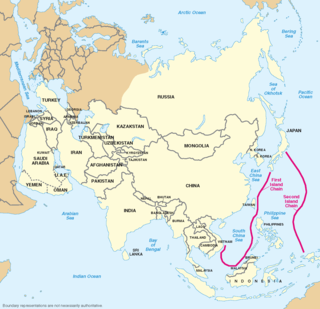
The island chain strategy is a strategic maritime containment plan first conceived by American foreign policy statesman John Foster Dulles in 1951, during the Korean War. It proposed surrounding the Soviet Union and China with naval bases in the West Pacific to project power and restrict sea access.
Geostrategy in Taiwan refers to the foreign relations of Taiwan in the context of the geography of Taiwan. Taiwan is an island country in East Asia, while it is also located at the center of the first island chain and commands the busy traffic of Taiwan Strait and Bashi Channel.

The U.S.-Japan Alliance is a military alliance between Japan and the United States of America, as codified in the Treaty of Mutual Cooperation and Security between the United States and Japan, which was first signed in 1951, took effect in 1952, and was amended in 1960. The alliance has further been codified in a series of "administrative" agreements, "status of forces" agreements, and secret pacts that have not been subject to legislative review in either country.

The main island of Okinawa accounts for 0.6% of Japan's land mass, though about 75% of United States forces in Japan are stationed in the Okinawa prefecture, encompassing about 18% of the main island of Okinawa. Following the ratification of the revised U.S.-Japan Security Treaty in 1960, massive protests of US military presence in Okinawa followed across Japan with an estimated 30 million Japanese citizens participating, known in Japan as the Anpo protest movement. With such a strong focus of United States Forces Japan in Okinawa, residents face economic problems of the highest unemployment in Japan as well as struggle for investment from outside businesses. Immense public opposition in Okinawa is still met with difficulty to create change for Okinawan citizens, while 25,000 American troops remain in Okinawa.
References
- ↑ Millard, Mike (1998). Okinawa, Then and Now. JPRI Occasional Paper. 11.
- ↑ Zartman, Matthew (2010). Military Basing and the United States-Japan Alliance. Georgetown University.
- ↑ Ikenberry, John(2003). America in East Asia. JAAS.
- ↑ Shimpo, Ryukyu(2011). “Moving Marines to Australia is a smart move". Ryukyu Shimpo.
- ↑ “Japan-United States Relations”. Encyclopedia of Modern Asia, Vol. 3, pp. 253-258.